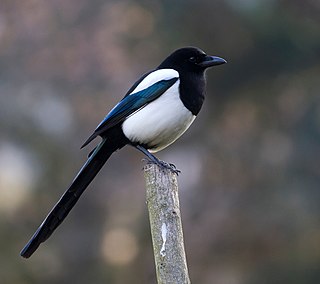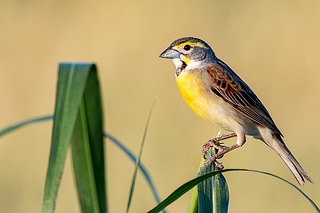
Kingfishers are a family, the Alcedinidae, of small to medium-sized, brightly coloured birds in the order Coraciiformes. They have a cosmopolitan distribution, with most species living in the tropical regions of Africa, Asia, and Oceania, but also can be seen in Europe. They can be found in deep forests near calm ponds and small rivers. The family contains 116 species and is divided into three subfamilies and 19 genera. All kingfishers have large heads, long, sharp, pointed bills, short legs, and stubby tails. Most species have bright plumage with only small differences between the sexes. Most species are tropical in distribution, and a slight majority are found only in forests.

Penguins are a group of aquatic flightless birds from the family Spheniscidae of the order Sphenisciformes. They live almost exclusively in the Southern Hemisphere: only one species, the Galápagos penguin, is found north of the Equator. Highly adapted for life in the ocean water, penguins have countershaded dark and white plumage and flippers for swimming. Most penguins feed on krill, fish, squid and other forms of sea life which they catch with their bills and swallow whole while swimming. A penguin has a spiny tongue and powerful jaws to grip slippery prey.

Eagle is the common name for the golden eagle, bald eagle, and other birds of prey in the family Accipitridae. Eagles belong to several groups of genera, some of which are closely related. True eagles comprise the genus Aquila. Most of the 68 species of eagles are from Eurasia and Africa. Outside this area, just 14 species can be found—two in North America, nine in Central and South America, and three in Australia.

Nightjars are medium-sized nocturnal or crepuscular birds in the family Caprimulgidae and order Caprimulgiformes, characterised by long wings, short legs, and very short bills. They are sometimes called goatsuckers, due to the ancient folk tale that they sucked the milk from goats, or bugeaters, their primary source of food being insects. Some New World species are called nighthawks. The English word "nightjar" originally referred to the European nightjar.

Birds of prey or predatory birds, also known as raptors, are hypercarnivorous bird species that actively hunt and feed on other vertebrates. In addition to speed and strength, these predators have keen eyesight for detecting prey from a distance or during flight, strong feet with sharp talons for grasping or killing prey, and powerful, curved beaks for tearing off flesh. Although predatory birds primarily hunt live prey, many species also scavenge and eat carrion.

Columbidae is a bird family consisting of doves and pigeons. It is the only family in the order Columbiformes. These are stout-bodied birds with short necks and short slender bills that in some species feature fleshy ceres. They primarily feed on plants, and can be taxonomically divided amongst granivores, that feed mostly on the ground on seeds, and frugivores, that feed mostly on fruits, from branches. The family occurs worldwide, often in close proximity with humans, but the greatest variety is in the Indomalayan and Australasian realms.

Magpies are birds of the family Corvidae. Like other members of their family, they are widely considered to be intelligent creatures. The Eurasian magpie, for instance, is thought to rank among the world's most intelligent creatures and is one of the few nonmammalian species able to recognize itself in a mirror test. Magpies have shown the ability to make and use tools, imitate human speech, grieve, play games, and work in teams. They are particularly well known for their songs and were once popular as cagebirds. In addition to other members of the genus Pica, corvids considered as magpies are in the genera Cissa, Urocissa, and Cyanopica.

The bulbuls are members of a family, Pycnonotidae, of medium-sized passerine songbirds, which also includes greenbuls, brownbuls, leafloves, and bristlebills. The family is distributed across most of Africa and into the Middle East, tropical Asia to Indonesia, and north as far as Japan. A few insular species occur on the tropical islands of the Indian Ocean. There are 166 species in 32 genera. While different species are found in a wide range of habitats, the African species are predominantly found in rainforest, whereas Asian bulbuls are predominantly found in more open areas.

Frigatebirds are a family of seabirds called Fregatidae which are found across all tropical and subtropical oceans. The five extant species are classified in a single genus, Fregata. All have predominantly black plumage, long, deeply forked tails and long hooked bills. Females have white underbellies and males have a distinctive red gular pouch, which they inflate during the breeding season to attract females. Their wings are long and pointed and can span up to 2.3 metres (7.5 ft), the largest wing area to body weight ratio of any bird.

The buntings are a group of Old World passerine birds forming the genus Emberiza, the only genus in the family Emberizidae. The family contains 45 species. They are seed-eating birds with stubby, conical bills.

Woodpeckers are part of the bird family Picidae, which also includes the piculets, wrynecks and sapsuckers. Members of this family are found worldwide, except for Australia, New Guinea, New Zealand, Madagascar and the extreme polar regions. Most species live in forests or woodland habitats, although a few species are known that live in treeless areas, such as rocky hillsides and deserts, and the Gila woodpecker specialises in exploiting cacti.

Starlings are small to medium-sized passerine birds in the family Sturnidae, common name of Sturnid. The Sturnidae are named for the genus Sturnus, which in turn comes from the Latin word for starling, sturnus. The family contains 128 species which are divided into 36 genera. Many Asian species, particularly the larger ones, are called mynas, and many African species are known as glossy starlings because of their iridescent plumage. Starlings are native to Europe, Asia, and Africa, as well as northern Australia and the islands of the tropical Pacific. Several European and Asian species have been introduced to these areas, as well as North America, Hawaii, and New Zealand, where they generally compete for habitats with native birds and are considered to be invasive species. The starling species familiar to most people in Europe and North America is the common starling, and throughout much of Asia and the Pacific, the common myna is indeed common.

Herons are long-legged, long-necked, freshwater and coastal birds in the family Ardeidae, with 72 recognised species, some of which are referred to as egrets or bitterns rather than herons. Members of the genera Botaurus and Ixobrychus are referred to as bitterns, and, together with the zigzag heron, or zigzag bittern, in the monotypic genus Zebrilus, form a monophyletic group within the Ardeidae. Egrets do not form a biologically distinct group from herons, and tend to be named differently because they are mainly white or have decorative plumes in breeding plumage. Herons, by evolutionary adaptation, have long beaks.

Cardinalidae is a family of New World-endemic passerine birds that consists of cardinals, grosbeaks, and buntings. It also includes several other genera such as the tanager-like Piranga and the warbler-like Granatellus. Membership of this family is not easily defined by a single or even a set of physical characteristics, but instead by molecular work. Among songbirds, they range from average-sized to relatively large, and have stout features, some species with large, heavy bills.

Pittas are a family, Pittidae, of passerine birds found in Asia, Australasia and Africa. There are 44 species of pittas, all similar in general appearance and habits. The pittas are Old World suboscines, and their closest relatives among other birds are in the genera Smithornis and Calyptomena. Initially placed in a single genus, as of 2009 they have been split into three genera: Pitta, Erythropitta and Hydrornis. Pittas are medium-sized by passerine standards, at 15 to 25 cm (5.9–9.8 in) in length, and stocky, with strong, longish legs and long feet. They have very short tails and stout, slightly decurved bills. Many have brightly coloured plumage.

The Eurasian blackcap, usually known simply as the blackcap, is a common and widespread typical warbler. It has mainly olive-grey upperparts and pale grey underparts, and differences across the five subspecies are small. Both sexes have a neat coloured cap to the head, black in the male and reddish-brown in the female. The male's typical song is a rich musical warbling, often ending in a loud high-pitched crescendo, but a simpler song is given in some isolated areas, such as valleys in the Alps. The blackcap's closest relative is the garden warbler, which looks quite different but has a similar song.

The garden warbler is a common and widespread small bird that breeds in most of Europe and in the Palearctic to western Siberia. It is a plain, long-winged and long-tailed typical warbler with brown upperparts and dull white underparts; the sexes are similar and juveniles resemble the adults. Its two subspecies differ only slightly and interbreed where their ranges overlap. Due to its lack of distinguishing features, this species can be confused with a number of other unstreaked warblers. The garden warbler's rich melodic song is similar to that of the blackcap, its closest relative, which competes with it for territory when nesting in the same woodland.

Ichthyornithes is an extinct group of toothed avialans very closely related to the common ancestor of all modern birds. They are known from fossil remains found throughout the late Cretaceous period of North America, though only two genera, Ichthyornis and Janavis, are represented by complete enough fossils to have been named. Ichthyornitheans became extinct at the Cretaceous–Paleogene boundary, along with enantiornitheans, all other non-avian dinosaurs, and many other animal and plant groups.

Parrots (Psittaciformes), also known as psittacines, are birds with a strong curved beak, upright stance, and clawed feet. They are conformed by four families that contain roughly 410 species in 101 genera, found mostly in tropical and subtropical regions. The four families are the Psittaculidae, Psittacidae, Cacatuoidea (cockatoos), and Strigopidae. One-third of all parrot species are threatened by extinction, with a higher aggregate extinction risk than any other comparable bird group. Parrots have a generally pantropical distribution with several species inhabiting temperate regions as well. The greatest diversity of parrots is in South America and Australasia.


















